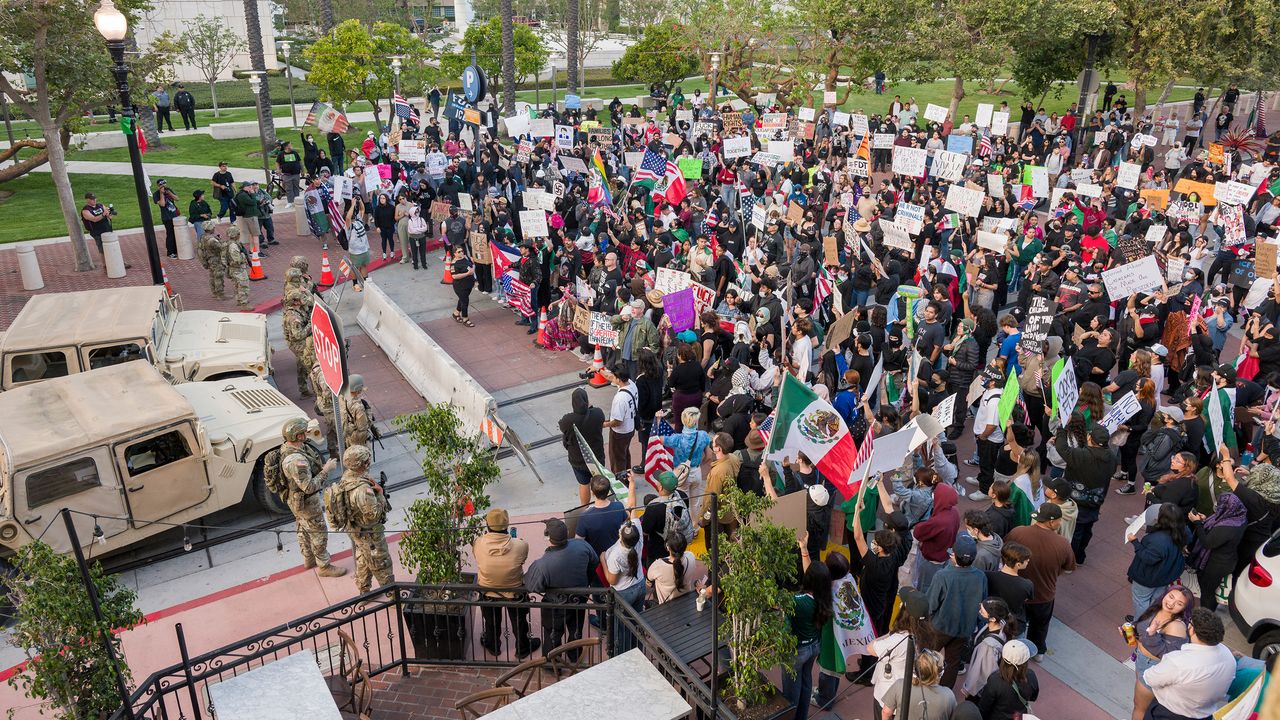Orange County Rapid Response Network is a loose association of volunteers—organizers and lawyers and hundreds of concerned residents—who help immigrants fight detention and deportation. On Monday morning, a hotline run by the group received an unusually high number of calls. Uniformed agents from the Department of Homeland Security had been spotted at various locations just west of Santa Ana, the county seat. They had streamed out of a maroon truck in the parking lot of a Home Depot and chased down a day laborer waiting to be hired outside. They had raided a car wash and apprehended someone at a bus stop. “We got a bunch of hits, and we mobilized our first responders to go and confirm the sightings,” Casey Conway, one of two full-time staffers at O.C. Rapid Response, told me. The network circulated warnings on social media, reached out to immigration lawyers, and guided family members through a kit on the “immediate steps to support your loved ones.”
O.C. Rapid Response was founded by a group of advocates and lawyers at the start of Donald Trump’s first term. Sandra De Anda, the other staffer, joined as a volunteer that year. De Anda is from a Latino and Cambodian neighborhood in Santa Ana, where ICE was often present. “We were seeing Immigration and Customs Enforcement target people at their homes,” she said. Orange County sits just below Los Angeles and has a population of 3.2 million people, thirty per cent of whom were born outside of the United States. Parts of the county have a strong immigrant identity, while others are proudly nativist. The surfing town of Huntington Beach, for instance, passed an ordinance earlier this year declaring itself a “Non-Sanctuary City for Illegal Immigration for the Prevention of Crime.”
Whereas ICE focussed on home arrests during Trump’s first term, President Joe Biden’s policy was to get people “straight from prison into detention,” Conway told me. Such targeted enforcement, which requires paperwork and time, seems to be over, De Anda explained. “Now it’s about numbers.” As soon as Trump returned to office, he issued an executive order that aimed to “significantly increase” the number of immigration officers and make expedited removal, a sped-up deportation process that had previously been used only at the border, a default policy. In February, Homeland Security launched a series of raids in L.A. Last month, ICE agents started to arrest and detain asylum seekers and other new arrivals at the immigration courthouse in Santa Ana, despite city and state sanctuary policies. A reporter named Ben Camacho found that the Santa Ana police had known on more than forty occasions since Trump’s Inauguration that immigration police would be conducting operations in the city. (Spokespeople for the city of Santa Ana and its police department declined to speak with me. ICE did not respond to my requests for comment.)
Last Friday, ICE led an operation at Ambiance Apparel, a garment wholesaler in Los Angeles, detaining workers and sparking daily protests. At least a few of those workers have already been deported. “We saw what was happening in L.A., and we were, like, it’s maybe a matter of time before they get to Orange County,” De Anda said.
On Monday, the Administration announced that it would deploy four thousand National Guardsmen and seven hundred marines to greater Los Angeles, claiming that they were needed “to enable federal law-enforcement officers to safely conduct their duties.” O.C. Rapid Response received reports of at least seven raids in the county that morning. The network posted an immediate “call to action” outside Santa Ana’s Civic Center Plaza, a government complex where arrested immigrants are processed:
NOW!
MASS ICE RAIDS
AROUND ORANGE
COUNTY ARE BEING
PROCESSED HERE.
Lets show them how
OC keeps its people
safe.
Detained immigrants were being transported to and from a government building in big white vans with tinted windows. Members of the network lined a driveway leading to the building and swarmed every van that came through. Conway counted fifteen vans in a matter of hours. O.C. Rapid Response could not free people from detention, but they could slow the process down and try to prevent deportation by getting people lawyers. Around noon, federal agents in riot gear pushed through to clear the way for a van. They shoved an older woman, fired rubber bullets, and used pepper spray on the protesters, including Conway. The liquid caught on his glasses and dripped into his eyes.
By the time I arrived, it was sunny and hot, and the demonstration had grown far beyond the network’s direct contacts. A couple hundred people filled the driveway. Every passing car seemed to honk and cheer in support. Vicente Sarmiento, an Orange County supervisor, was in attendance. “I was at Home Depot this morning, and it broke my heart to see six people being taken away,” he told the crowd. An organizer instructed them to write “Grabate y llama este # 9233#” (“Record yourself and call this number”) on their signs and hold them up when a van came through. The number would connect detainees to legal aid. Fernando, a thirty-one year-old delivery driver, told me that he had come because ICE was “just abducting people.” He continued, “I’m Mexican, and I have family that’s scared. I don’t even want my mom to go out.” Down the street, about a dozen armed and helmeted federal agents stood at the main entrance to the building.
A phalanx of Santa Ana police officers appeared at the opposite end of the street in the late afternoon. The protesters moved away from them, in the direction of the federal agents. People threw plastic water bottles, and the agents responded with pepper balls and tear gas. People ran. Amid the chaos, two white vans drove through a gap created by the Santa Ana police and into the ICE processing center.
That night, De Anda and Conway led a training session for people interested in becoming “ICE watchers.” The network held such events every month or so and, ordinarily, attracted twenty or thirty people. This time, more than three hundred had R.S.V.P.’d, requiring a last-minute scramble for a larger venue. Those who came were of every race, age, and gender. They filled the seats and floorspace of a lecture hall, then two overflow rooms, at Santa Ana College. De Anda went through a series of wonky slides but kept things lively; she writes fiction and does standup comedy on the side. She explained that, because ICE hadn’t had much luck gaining access to people’s homes, they now seemed to prioritize outdoor areas. She referenced a recent court decision holding that immigration police cannot enter the areas surrounding a residence—a covered porch, a carport, or a back yard—without a judicial warrant. (I learned a new word: “curtilage.”) Conway was exhausted from the protest and the pepper spray; he played a supporting role and ordered pizzas for the crowd.
O.C. Rapid Response is one of two dozen similar networks in California, including Ventura County Defensa and Stand Together Contra Costa. Several members of partner groups were at the training, including Amina Fields, an immigration lawyer at the Council on American-Islamic Relations of California. Earlier in the day, she had held a “NO HATE / NO BAN” sign at Los Angeles International Airport, to oppose Trump’s new travel restrictions on citizens of nineteen countries, in the Middle East, Africa, and the Caribbean. Now Fields was trying to figure out how to support the immigrants who had been taken into ICE custody. “O.C. Rapid Response has created a list of who was recorded being detained, and now we’re going through it,” she told me. “From the legal side, it’s much harder once they’re detained.” Like De Anda and Conway, who is the child of a Vietnamese refugee, Fields has personal connections to these efforts. When she was young, she emigrated from Vietnam by way of a Thai refugee camp, and she spent a decade in the U.S. Air Force before going to law school. She was angered by Trump’s deployment of the National Guard and the Marines. “To put them against their own community members, their own family members—there is no need to have the military here,” she said.
On Tuesday morning, the O.C. Rapid Response hotline was still buzzy. Hundreds gathered again outside the building where detainees were taken—and were met by a frightening display of tactical vehicles and National Guardsmen. “It feels like an occupation,” De Anda told me. “They are doing as they have been directed, to destabilize our communities, our economy.” Reports of ICE raids spread. On Instagram, the network distributed whatever information it could verify on the movements of Homeland Security. “We received an anonymous tip that ICE is going to be present at the Orange County Social Services building on South Grand Avenue, Santa Ana either today or tomorrow,” one post read in English and Spanish.
That day, Pete Hegseth, the Secretary of Defense, told a House Subcommittee that the National Guard members and Marines could be in greater L.A. for two more months. The estimated cost was a hundred and thirty-four million dollars, just to cover food, transportation, and lodging. “I think we’re entering another phase, especially under President Trump, with his focus on the homeland,” he said. The National Guard would be a “critical component.” (A federal appeals court will soon consider whether to uphold a lower court’s decision to temporarily block the mobilization.)
Military convoys sped down Interstate 5; an ICE checkpoint went up at an exit near a school. Governor Gavin Newsom gave a speech after Hegseth testified, saying, “Other states are next. Democracy is next.” There were marches in Austin, Philadelphia, New York, San Francisco, and Seattle. In Southern California, rapid response became the strategy of the moment. Every union and nonprofit seemed to be advertising a help hotline and know-your-rights materials. Community group chats, focussed on particular neighborhoods, proliferated on Signal. In Arcadia, northeast of L.A., protesters yelled and banged on instruments for twelve hours outside a Hilton Garden Inn that was housing ICE officers; by Tuesday night, the officers packed up and left. Tom Homan, Trump’s border czar, admitted that demonstrations were making enforcement “more difficult.” He told the right-wing activist and podcaster Charlie Kirk that ICE required more resources to carry out mass deportations: “We need more officers. Need more beds. Need more planes.”
O.C. Rapid Response tried to celebrate a small win. In the course of tracking down a community member who had been arrested, using ICE’s “online detainee locator system,” the network discovered that the city of Glendale, in L.A. County, had an active federal contract to hold immigrants in its jail. The contract apparently predated the state’s 2017 sanctuary law, and was permitted as an exception. A few days after O.C. Rapid Response members and the lawyer representing the community member publicized the issue, Glendale cancelled the contract. The decision was “not politically driven,” the city said.
That meant one less way station, but the community member still ended up detained. As of this month, more than fifty-one thousand immigrants are in ICE detention, the highest number since 2019. And California’s largest private facility, the Adelanto Detention Center, owned by the GEO Group, recently resumed business, after the settlement of a class-action lawsuit over unsafe conditions during the pandemic. Late last year, because of that litigation, the facility held just three inmates; it can now house up to nineteen hundred. “In this work, you have to accept the David role, as in David and Goliath,” Conway told me. “A lot of victories will feel like losses, but it’s still resistance.” ♦
Premium IPTV Experience with line4k
Experience the ultimate entertainment with our premium IPTV service. Watch your favorite channels, movies, and sports events in stunning 4K quality. Enjoy seamless streaming with zero buffering and access to over 10,000+ channels worldwide.

















